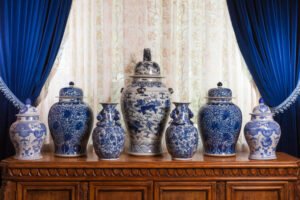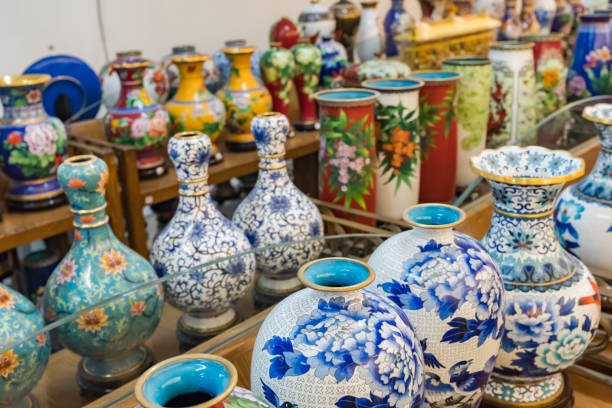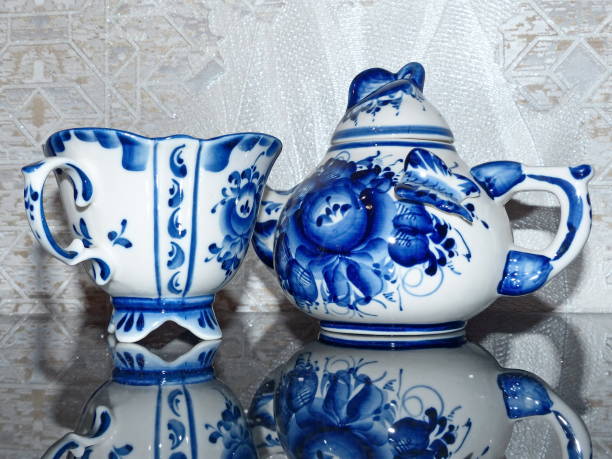Lotus Pattern Importance in Cultural Decor
The ginger jars, especially lotus-patterned ones, are a home design mainstay. Originally used in China to store spices and other things, these little porcelain pots symbolize beauty and culture. These jars often have lotus patterns, symbolizing many cultures, especially Asian ones. An article on the lotus motif’s cultural and spiritual significance and its impact on decorating styles shows how a simple floral pattern can carry deep meanings.

Many Asian civilizations revere the lotus flower because of its unusual lifecycle. It grows from murky waters but looks gorgeous above the water. Due to their growing cycle, lotuses symbolize purity, enlightenment, and rebirth. The lotus flower represents cultural values and aspirations on ginger jars, not just decoration. Chinese culture associates the lotus pattern with ‘lian,’ which means integrity and purity. This relationship permeates Chinese culture and art.
Lotus symbolism is more potent in Buddhism. Buddha’s lotus birth symbolized heavenly birth and spiritual awakening. White, pink, and blue flowers symbolize spiritual purity and the soul’s journey to enlightenment. These motifs, which appear on everyday objects like ginger jars, remind us of these spiritual aspirations daily.
Lotus patterns are beautiful in home design beyond their cultural and spiritual meanings. Layers of petals spread outwards to provide the space it occupies in balance and harmony. Lotus-decorated ginger jars can change a room’s spirit and atmosphere. According to Feng Shui, the lotus pattern enhances positive energy, turning ordinary areas into peaceful retreats.
Cultural preservation can be achieved by decorating with lotus-patterned ginger jars. Each jar has a tale about its beginnings and the individuals who respected these symbols enough to incorporate them into ordinary goods. Collectors and designers value these jars for their history and heritage. The revival of classic motifs like the lotus design reflects a movement toward culturally inspired interiors where every piece has meaning beyond its aesthetic value.
Artisans create elaborate lotus patterns on ceramic ginger jars, demonstrating their expertise and imagination. Before firing, traditional methods entail painstakingly hand-painting or carving each motif into clay. This artistry makes the ginger jars look better and adds character. Every jar is unique because its craftsman touched every stroke and carving.
Modern lotus patterns in decor honor historic motifs but add modern components, making them suited for modern dwellings. Designers can combine antique art with modern design by varying lotus pattern scale, color, and positioning. This fusion technique has kept the lotus pattern relevant in contemporary home design, appealing to a broad audience who understands its beauty and cultural value.
Lotus patterns in ginger jars represent social values, aspirations, beauty, and symbolism. Many cultures use art and design with deep meanings to express values and beliefs. It values beauty and spirituality and links the personal and communal through cultural symbols. Cultural d cor may bridge civilizations and inspire understanding and respect in a globalized society.
The popularity of lotus-patterned ginger jars has impacted fabrics, wallpaper, and furniture, demonstrating the motif’s adaptability and longevity. This widespread acceptance shows the design’s universal features, which transcend culture and geography.
The little porcelain ginger jar with a lotus motif is more than a container. A cultural artifact, it combines history, spirituality, and aesthetics. Whether in a quiet corner of a home or publicly displayed in a collection, it reminds us of the human search for beauty and significance.
Curating Atmosphere: Small Patterned Jars in Intimate Spaces
Ginger jars, especially those with elaborate patterns like the lotus, have become essential to creating private, contemplative places in modern houses. Instead of being decorative vessels, these small porcelain jars are increasingly crucial to building peaceful and customized spaces. The delicate lotus pattern on such jars adds depth and contemplation to any setting, making them excellent for quiet and serene spaces.
Small patterned jars can stand out as focal points or merge into a more diverse arrangement, making them appealing in decor. Due to their adaptability, they are ideal for reading nooks, bedside tables, and quiet study. Lotus-patterned jars add serenity and concentration to these settings. Visual texture and historical significance refine the design without overloading the senses.
A modest ginger jar can anchor the design in a reading corner. The jar enhances the space’s quiet and meditative ambiance when placed on a shelf or amid a stack of treasured books. The lotus pattern’s cultural and spiritual significance encourages a slower, more contemplative day. In these moments, while reaching for a book or sitting down, the unique jar design catches the light and eye, providing a visual break from the printed text.
A small table by the bed can become a personal retreat with these jars. The jar may house a single bloom or be empty, with its pattern as the focus. In either instance, it is a decoration and part of the evening or morning ritual, symbolizing serenity and calm in the home. The lotus design on a pottery jar helps calm the mind before bed or upon rising with its peaceful symmetry and smooth outlines.
A ginger jar can break up the monotony of books and papers in private studies or home offices, where thoughts and considerations are common. A lotus-patterned jar on a desk or bookshelf does more than beautify. It might provide a visual reprieve from computer screens and other endeavors. Its historical significance and artistic appeal can inspire or calm many amid work.
Small jars can add charm to kitchens and bathrooms. A lotus-patterned jar on a kitchen windowsill, away from appliances and cookware, can add elegance to the room. These jars can adorn bathroom vanity tops by carrying basics or adding beauty.
Strategically placing these jars can affect room energy and flow. According to Feng Shui, lotuses represent purity and spiritual awakening, which can boost qi in an area. Locating a lotus-patterned ginger jar that can be seen from many angles optimizes its energy impact on the room, creating harmony and balance.
Additionally, a jar’s color and pattern intricacy might affect the space. Lighter colors and simpler patterns make tiny spaces feel open and breezy, while darker or more detailed designs can create focus points and depth.
Thoughtful arrangement and context elevate little patterned jar decor in intimate areas. These jars, especially ones with symbolic designs like the lotus, convey history, culture, and personal style. They show us that beauty and art may be in quiet times.
Small ceramic ginger jars are charming since they blend in with their environment, making personal settings more intimate and unique. These jars enhance the ambiance of quiet, reflective places, adding to the sensation of tranquility and solitude.




